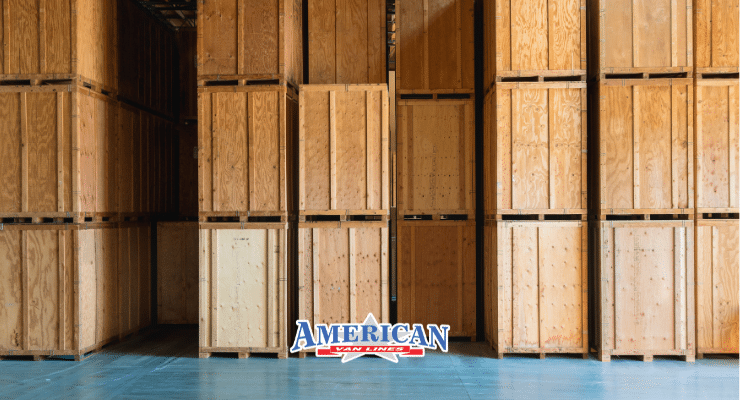You can’t move cash, furs, or valuable personal papers like stocks and bonds aboard a commercial moving vehicle. Dangerous items are prohibited as well. However, valuables such as antiques and pianos are allowed to travel aboard licensed moving company vehicles. You should consider employing special means to protect them, but you’re allowed to ship these types of valuable items aboard a moving truck:
- Antiques
- Artwork
- Electronics
- TVs
- Pianos.
Most valuable items can be afforded extra protection from the hazards of the road by encasing them in custom-built wooden crates. A team of craftsmen appears at your home to build the crates before you move. You supply them with the dimensions and measurements of your valuable items, and the team arrives with all that’s needed to pad, wrap, and crate your goods for safety during transportation. Once they’re crated, your valuables can be strapped to the sides of the van so they don’t shift position.
Antiques and TVs: Safeguard Your Fragile Valuables with Custom Crating
TVs are among the most popular crated items. When people compare the price of replacement insurance for their 98-inch TV set against the cost of building a crate, they opt for the wood. If your valuable item is irreplaceable or one-of-a-kind, the cost of custom crating pales in comparison to its sentimental or dollar-based valuations. You need something that works, and custom crating fits the bill.
It’s not a complete enclosure. Your craftsman uses wooden slats to create a frame around the piece that conforms to the exact dimensions of your piece. All these guys do is build crates for people’s possessions, so they’ve seen it all. They’ll nail together a wooden crate that looks like a second skin. Expect them to measure three times before they cut. These craftsmen know what they’re doing.
Use Custom Crating to Shelter Your Irreplaceable Goods on the Road
Your custom crate is constructed by third-party vendors who appear at your home before shipping. Since they assume responsibility for the product once it’s crated, the company will send a different team of technicians to uncrate your product at your new place. They come armed with all the supplies needed based on the dimensions you relayed. With precise measurements, it’s easy to know how many wooden slats are required.
Antiques and TVs are wrapped in cotton pads and shrink wrap before crating. The method used depends on the item, though, because the crates are built tightly around it. The goal is to prevent the item from shifting within the crate. Custom crating is the best way to protect your irreplaceable antiques against the rigors of the road. When insurance isn’t enough, think about custom crating.
Pianos and Other Musical Instruments: Extra Padding Often Required
Pianos aren’t crated, but the largest and most valuable pianos do need special handling. Upright and console pianos are made to be handled just like any other piece of furniture. Grand pianos and baby grands, however, require special techniques. Sometimes, pieces need to be removed. All of the larger pianos are moved best using a unique piece of moving equipment called a piano moving board. Strapping a large piano to a moving board makes it easy to handle.
We’ve crated jukeboxes, chandeliers, framed art, and sculptures, to name a few things. If you don’t have custom cases for your drums or guitars, they can be built out of wood to protect your valuable items. Anything fragile, from irreplaceable china to sensitive electronics, can be assigned extra padding before it’s securely crated. Once it’s crated, your oddly shaped item suddenly becomes easy to maneuver. Since the crates are nailed together, they’re easy to disassemble using the claw end of a hammer.
Using Piano Moving Boards Makes Piano Moving Much Easier
Professional piano movers use moving boards to stabilize the instrument for travel. If done properly, you might not have to remove the piano top. Your movers will wrap your grand piano or baby grand, using both cloth pads and shrinkwrap. The moving board, which conforms to the design of the flat side of your piano, is laid on the moving dolly. Your wrapped piano is placed on its flat side on the moving board and then secured to the board with ropes. The legs are unscrewed after the piano is boarded.
The moving board provides a safe foundation, allowing you to wheel the piano to the truck and lift it onboard with the moving board still attached. The padded moving board provides a softer ride than the truck’s floor. You’ll have to carry the piano up any stairs, but you can wheel it through tight doorways or hallways. Professional piano moves usually carry two versions of moving boards with notches crafted to fit, one for grand pianos and one for baby grand.
Trust American Van Lines to Handle Your Valuable Antiques and Pianos
Custom crating can be expensive. If you retain your original TV box and its protective padding, you can use it. But who does that? Really, the only safe way to protect your most delicate items is to construct solid protection that conforms to the dimensions of your object. You should think about crating an item for a long-distance move if you think it’s particularly:
- Fragile
- Valuable
- Irreplaceable
- Uniquely Shaped
When it comes to relocating large pianos, technique, and equipment are paramount. People get injured moving large pianos, and difficulties arise. We’ve had to use cranes to deliver people’s pianos in high-rises where they don’t fit in the elevators. Experience helps when your best plans go awry. Call American Van Lines, a company with almost 30 years of moving experience, to handle your most valuable items efficiently and safely.







